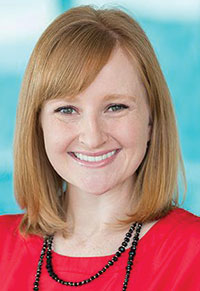
Heather Hoch
People truly have strong feelings about the proper diagnosis and management of difficult-to-treat and severe asthma in children, according to Heather Hoch, MD, assistant professor of pediatrics-pulmonary medicine at the University of Colorado in Aurora.
The topic not only incites emotions, but also generates a number of opinions, especially because there are multiple components that influence diagnosis and treatment.
“There are so many different components that we could have discussed; however, we chose to focus on obesity as a comorbidity, adherence, biologic therapy, and bronchoscopy as areas that affect many of our patients,” said Dr. Hoch, co-chair of this morning’s session. The session will also provide a unique perspective on the topic through the lens of a patient representative on the panel.
This session also will examine the topical recent Global Initiative for Asthma (GINA) severe asthma guidelines, which were released in November.
“The discussion will focus on the flow diagram (from the GINA guidelines) in which difficult-to-treat asthma is assessed—first, evaluating comorbidities and assessing treatment adherence, and, if the patient is still symptomatic after optimizing these, moving on to biologic therapy, and bronchoscopy for further evaluation,” Dr. Hoch said.
Dr. Hoch will explore the role medication adherence plays in difficult-to-treat asthma in children. This discussion will evaluate the current literature regarding the burden of poor medication adherence in children with asthma, describe current methods for clinicians to evaluate adherence, and discuss strategies for improving medication adherence.
Deepa Rastogi, MBBS, MS, director of the Pediatric Asthma Center and assistant professor of pediatrics at the Children’s Hospital at Montefiore in Bronx, New York, will speak to immune dysfunction in children with obese asthma. She also will explore the links between non-atopic systemic inflammation, metabolic abnormalities, and lung function deficits found in pediatric obesity-related asthma, emphasizing the mechanisms by which metabolic abnormalities contribute to systemic non-atopic inflammation, focusing on the epigenomic and transcriptomic alterations in obese asthmatic T cells and their association with lung function deficits.
Stephanie Lovinsky-Desir, MD, attending physician in the pediatric pulmonary division and assistant professor of pediatrics at Columbia University, will cover the biologic therapies for childhood asthma that are currently available for use in the pediatric population with a summary of indications, efficacy in clinical trials versus real-world settings, and what is known about cost effectiveness.
Difficult-to-Treat and Severe Asthma in the Pediatric Population (C9)
9:15-11:15 a.m., Tuesday
Dallas Ballroom A-C (Level 3), Omni Dallas Downtown
Alfin Vicencio, MD, professor of pediatrics at Mount Sinai Medical Center, will review the initial use of bronchoscopy in adult and pediatric patients with asthma, provide examples of common anatomic problems encountered, review prior research efforts employing bronchoalveolar lavage and mucosal biopsy, introduce non-culture-based methods that may enhance asthma care, and offer concrete and recent examples of how such methods have informed management.
“We want to help people get better at targeting ways they can affect patient care—treating and recognizing comorbidities, and the difficult issue of medication adherence,” Dr. Hoch said. “We’ll offer concrete ways they can evaluate patients with asthma prior to stepping up to other therapies.”
Educational Grant Support: Genentech, Inc., GlaxoSmithKline, Novartis Pharmaceuticals Corporation, Sanofi Genzyme and Regeneron Pharmaceuticals.
